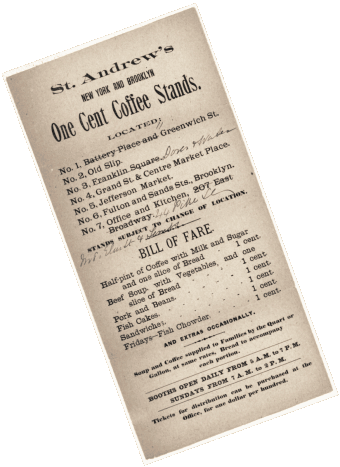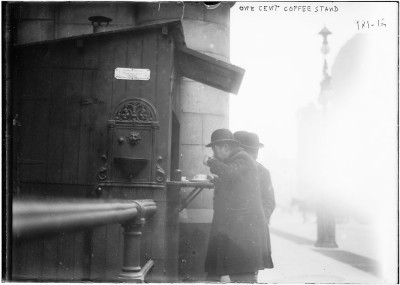Half a pint of coffee, with milk and sugar and a slice of bread, 1 cent
In New York City in January 1887, one Mrs. Joaquin M. Lamadrid opened her first of many booths to serve coffee and food to the poor of New York. She called them St Andrew's One Cent Coffee Stands. (They were not affiliated with any church or religious group, but rather named after the disciple Andrew who, according to the New Testament gospel of John, found the boy who had the five loaves and two fishes that Jesus served to the five thousand.) The Stands served not only bread and coffee, but full meals as well, including fish-on-Fridays. Click on the picture to the left for a larger image of the Stands' 'Bill of Fare'. By 1895, the stands were serving more than two thousand people a day and continued in operation until the 1930's.
A One-Cent Stand in New York, 1900. The sign on the stand reads:
The Greater New York Philanthropic Society, The One Cent Coffee StandsMore about the One Cent Coffee Stands can be found in Frank Leslie's Sunday Magazine of 1887.
What did coffee and bread cost in 1900? At the turn of the century, a pound of pre-packaged coffee was about 15-20 cents. Brewed to "modern" standards of 4oz per half-gallon, a pound would make two gallons or 16 pints of brewed coffee, or about a penny a cup. A loaf of bread was only a few cents, so a "slice" should have been a penny or less.
Nowadays, that pint of coffee from Mountain City would cost about 40¢. You could do cheaper (but not better) with, say, Folgers from a supermarket, but it would still run you 20¢ per pint. A loaf of bread costs about $1 for grocery brands to $4 for an artisan product, so bread and coffee today would be in the range of 25 - 65¢, though the low end would be comparable to what Mrs. Lamadrid was serving a century ago.





